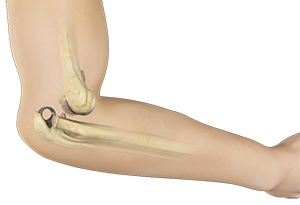
What is Elbow Dislocation?
The arm in the human body is made up of three bones that join to form a hinge joint called the elbow. The upper arm bone or humerus connects from the shoulder to the elbow to form the top of the hinge joint. The lower arm or forearm consists of two bones, the radius and the ulna. These bones connect the wrist to the elbow forming the bottom portion of the hinge joint.
The bones are held together by ligaments to provide stability to the joint. Muscles and tendons move the bones around each other and help to position the hand in space to perform various activities. An elbow dislocation occurs when the bones that make up the joint are forced out of alignment.
Causes of Elbow Dislocation
Elbow dislocations usually occur when you fall onto an outstretched hand. It can also occur from a traumatic injury such as a motor vehicle accident.
Symptoms of Elbow Dislocation
When the elbow is dislocated you may experience severe pain, swelling and lack the ability to bend your arm. You may feel a pop or clunk when the elbow slips out of place.
Diagnosis of Elbow Dislocation
To diagnose an elbow dislocation, your doctor will examine your arm. Your doctor will also check the pulses at the wrist and evaluate the circulation to the hand. An X-ray is necessary to confirm the dislocation and determine if there is a break in the bone.
Treatment Options for Elbow Dislocation
An elbow dislocation is a serious injury and requires immediate medical attention.
What your Doctor Does to Treat an Elbow Dislocation
Your doctor will put your dislocated elbow back in place by pulling on your wrist and levering your elbow. This procedure is known as a reduction. You may be given medication to relieve your pain before the procedure. After the reduction, you may have to wear a splint to immobilize your arm at the elbow. After a few days, you may also need to perform gentle motion exercises to improve your range of motion and strength.
Related Topics
- Triceps Injuries
- Osteochondritis Dissecans of the Capitellum
- Elbow Trauma
- Elbow Arthritis
- Bicep Tendon Tear at the Elbow
- Elbow Dislocation
- Triceps Tendonitis
- Elbow (Olecranon) Bursitis
- Elbow Sprain
- Tennis Elbow
- Golfer's Elbow
- Little League Elbow
- Nursemaid's Elbow
- Elbow Pain
- Elbow Contracture
- Distal Humerus Fractures of the Elbow
- Radial Head Fractures of the Elbow
- Elbow Fractures
- Ulnar Nerve Neuropathy
- Loose Bodies in the Elbow
- Radial Tunnel Syndrome
- Lateral Ulnar Collateral Ligament Injuries (Elbow)
- Post-traumatic Stiffness (Elbow)
- Cubital Tunnel Syndrome (Ulnar Nerve Entrapment)





